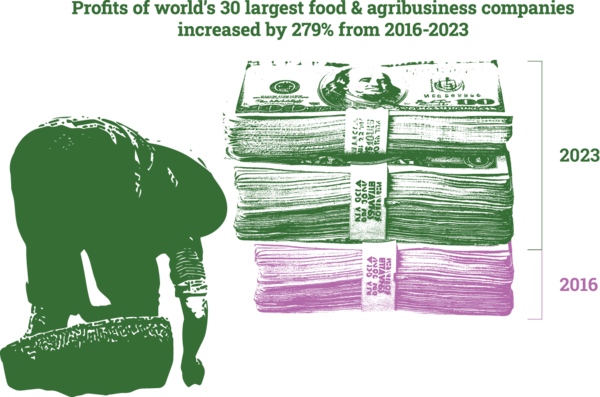There is no way to deal with the climate crisis without addressing how we produce and consume food. The food system is a major driver of climate change, accounting for over a third of global greenhouse gas emissions,. But it is also a major casualty of it, with people’s ability to grow crops, raise livestock and access food increasingly disrupted by the effects of climate change. We need to urgently transform our food systems to adapt. But to do so, we have to be clear on what’s the problem and what’s the solution.
In this new poster, GRAIN breaks down the culprits and the solutions when it comes to food and the climate crisis.
Below you may find the html adaptation of this poster.
Food & the climate crisis: What’s the problem? What’s the solution?
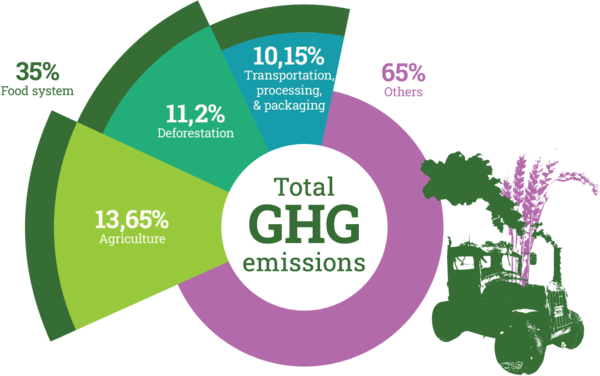 The industrial food system is driving climate change: The industrial food system accounts for more than one-third of all global greenhouse gas emissions. Most of this pollution comes from: intensive livestock production for meat and dairy, the tremendous waste of food, our reliance on global trade instead of locally source foods, land grabbing and deforestation for the expansion of large plantations, and the heavy use of chemical pesticides and fertilisers.[1]
The industrial food system is driving climate change: The industrial food system accounts for more than one-third of all global greenhouse gas emissions. Most of this pollution comes from: intensive livestock production for meat and dairy, the tremendous waste of food, our reliance on global trade instead of locally source foods, land grabbing and deforestation for the expansion of large plantations, and the heavy use of chemical pesticides and fertilisers.[1]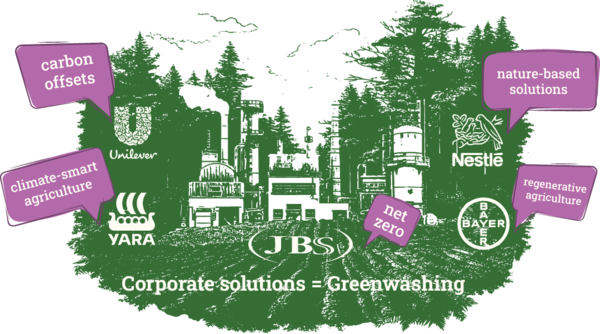 Food is power: Farmers are not to blame. Companies are. They run the industrial food system for their own financial interests. Corporate influence over governments and international agencies leads to inaction on climate emissions in addition to the laws, regulations and subsidies that entrench the industrial food system. Food and agribusiness companies use greenwashing and false solutions like “offsets” to create new revenue streams for themselves while they undermine real solutions like agroecology and food sovereignty.
Food is power: Farmers are not to blame. Companies are. They run the industrial food system for their own financial interests. Corporate influence over governments and international agencies leads to inaction on climate emissions in addition to the laws, regulations and subsidies that entrench the industrial food system. Food and agribusiness companies use greenwashing and false solutions like “offsets” to create new revenue streams for themselves while they undermine real solutions like agroecology and food sovereignty.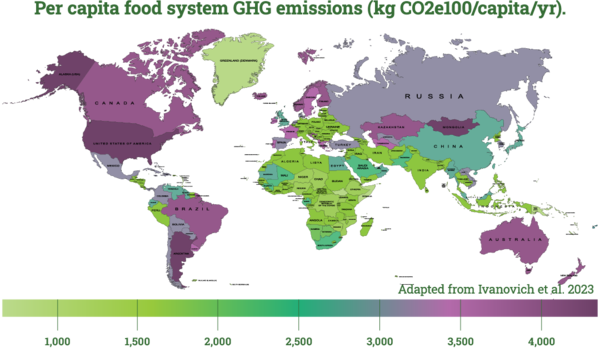
Broader impacts: The industrial food system is also a leading cause of biodiversity collapse, declining water tables and pollution, soil degradation, deforestation and labour exploitation. It is a major source of health problems caused by pesticides and the consumption of ultra-processed foods. And because the system is structured to generate benefits for corporations, we see hundreds of millions of people going hungry in the midst of food surpluses. Day by day, corporations expand their operations and markets through the destruction and criminalisation of local food systems, preventing communities from using their own lands, water, seeds and traditional practices and displacing them from their territories. It leaves people at the mercy of investors in far off boardrooms to decide what gets grown and who gets fed. The consequences of this are becoming more severe as the climate crisis puts increasing stress on global food production. [3] [4]
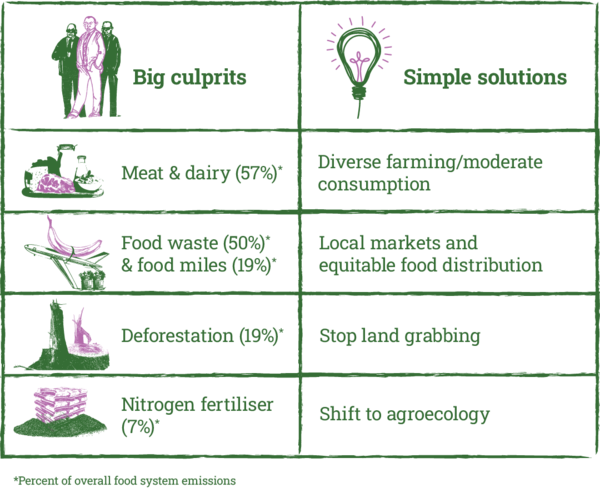 The solution is food sovereignty: We can address climate change by tackling the biggest source of food-related emissions while ensuring that people have sufficient access to nutritious foods and communities can maintain their livelihoods. With meat and dairy, we must stop large scale industrial animal farming and shift to local, diverse production systems that provide people with a moderate amount of meat and dairy, using local feed sources. We can slash food waste and food miles by creating more direct links between food producers and consumers, dismantling free trade agreements and ensuring that regulations and policies support peasant-led agroecological production and marketing systems and protect them from the dumping of imports. These measures, along with increased community control over territories, will also curb deforestation. And we can phase-out chemical fertilisers through a massive transition to agroecological practices that build up soil health and keep carbon in the soil.[5]
The solution is food sovereignty: We can address climate change by tackling the biggest source of food-related emissions while ensuring that people have sufficient access to nutritious foods and communities can maintain their livelihoods. With meat and dairy, we must stop large scale industrial animal farming and shift to local, diverse production systems that provide people with a moderate amount of meat and dairy, using local feed sources. We can slash food waste and food miles by creating more direct links between food producers and consumers, dismantling free trade agreements and ensuring that regulations and policies support peasant-led agroecological production and marketing systems and protect them from the dumping of imports. These measures, along with increased community control over territories, will also curb deforestation. And we can phase-out chemical fertilisers through a massive transition to agroecological practices that build up soil health and keep carbon in the soil.[5] Peasant agroecology now: Scientific evidence shows that agroecology is better at providing both food security and nutrition for communities in most parts of the world than Green Revolution type strategies.[6] This means crop rotations and mixtures, integrated plant and animal production, agroforestry, organic inputs, locally adapted seeds, traditional knowledge and good soil and water management strategies. But agroecology is far more than a set of techniques. It is an approach to agricultural work and food provisioning that is grounded in territory, knowledge and culture. It needs to be peasant-led in order to keep power and vision in the hands of small scale producers, particularly women.
Peasant agroecology now: Scientific evidence shows that agroecology is better at providing both food security and nutrition for communities in most parts of the world than Green Revolution type strategies.[6] This means crop rotations and mixtures, integrated plant and animal production, agroforestry, organic inputs, locally adapted seeds, traditional knowledge and good soil and water management strategies. But agroecology is far more than a set of techniques. It is an approach to agricultural work and food provisioning that is grounded in territory, knowledge and culture. It needs to be peasant-led in order to keep power and vision in the hands of small scale producers, particularly women. 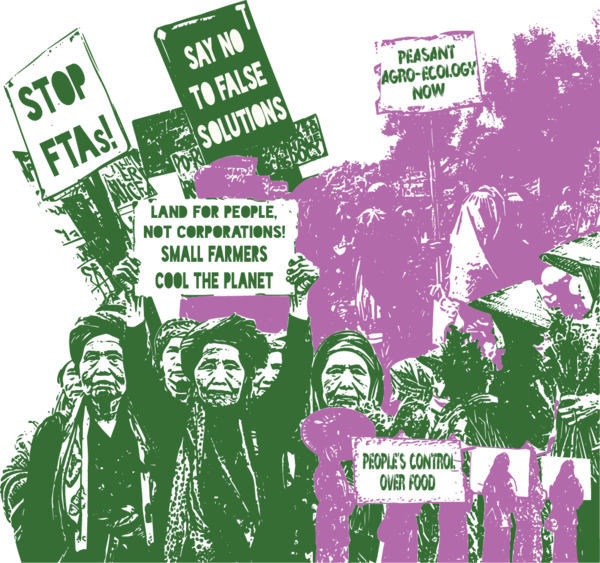 Put communities in control: The fight against climate change in and from our food systems must ensure that communities have control over their territories and that food producers, not corporations, set policies. Many initiatives are being taken by social movements, occasionally backed up by public authorities, to move us in the right direction. Actions that seek to break up corporate domination in different parts of the food chain, strengthen local markets, redistribute land, create food reserves and food social security systems, dismantle the current trade regime, promote farmer seed systems and empower food workers are all crucial steps. In the end, only community control over resources, systems and knowledge will give us food systems that are climate resilient and grounded in justice.
Put communities in control: The fight against climate change in and from our food systems must ensure that communities have control over their territories and that food producers, not corporations, set policies. Many initiatives are being taken by social movements, occasionally backed up by public authorities, to move us in the right direction. Actions that seek to break up corporate domination in different parts of the food chain, strengthen local markets, redistribute land, create food reserves and food social security systems, dismantle the current trade regime, promote farmer seed systems and empower food workers are all crucial steps. In the end, only community control over resources, systems and knowledge will give us food systems that are climate resilient and grounded in justice._________________________________
[1] C. Costa et al. "Roadmap for achieving net-zero emissions in global food systems by 2050", Scientific Reports, 12, 15064, 2022: https://doi.org/10.1038/s41598-022-18601-1; UNEP, "Driving finance for sustainable food systems: A roadmap to implementation for financial institutions and policy makers," April 2023: https://www.unepfi.org/publications/driving-finance-for-sustainable-food-systems/
[2] ETC Group, "Small scale farmers and peasants still feed the world", January 2022: https://www.etcgroup.org/files/files/31-01-2022_small-scale_farmers_and_peasants_still_feed_the_world.pdf
[3] International Panel of Experts on Sustainable Food systems, "From uniformity to diversity: a paradigm shift from industrial agriculture to diversified agroecological systems", 2016: https://www.ipes-food.org/_img/upload/files/UniformityToDiversity_FULL.pdf
[4] Forbes’ Global 2000.
[5] Xiaoming Xu et al., "Global greenhouse gas emissions from animal-based foods are twice those of plant-based foods", Nature Food (2), 2021: https://www.nature.com/articles/s43016-021-00358-x; Jingyu Zhu, "Cradle-to-grave emissions from food loss and waste represent half of total greenhouse gas emissions from food systems", Nature Food (4), 2023: https://www.nature.com/articles/s43016-023-00710-3; Mengyu Li et al., "Global food-miles account for nearly 20% of total food-systems emissions", Nature Food (3), 2022: https://www.nature.com/articles/s43016-022-00531-w; Stefano Menegat et al., "Greenhouse gas emissions from global production and use of nitrogen synthetic fertilisers in agriculture", Scientific Reports, 2022: https://www.nature.com/articles/s41598-022-18773-w
[6] Guy Faure et al, “What agroecology brings to food security and ecosystem services: a review of scientific evidence”, Desira-Lift, February 2024, https://agroecology-coalition.org/wp-content/uploads/2024/02/DeSIRA-LIFT-Knowledge-brief4-Scientific-Evidence-for-Agroecology.pdf
